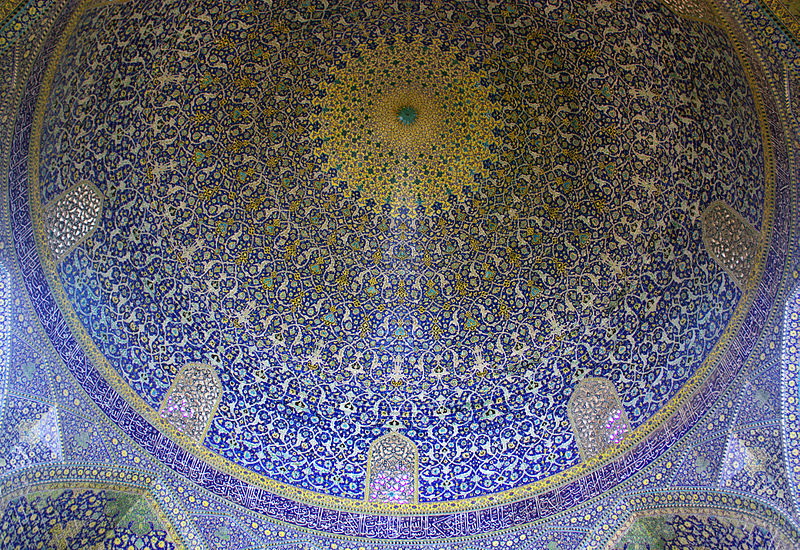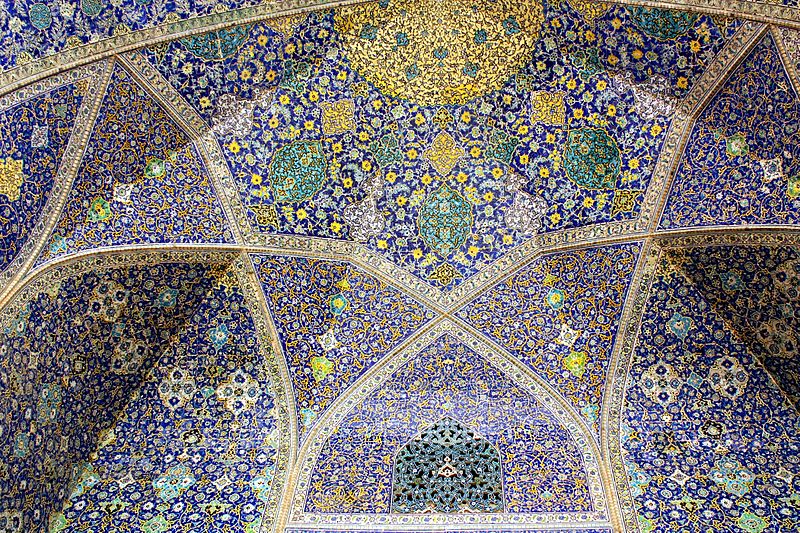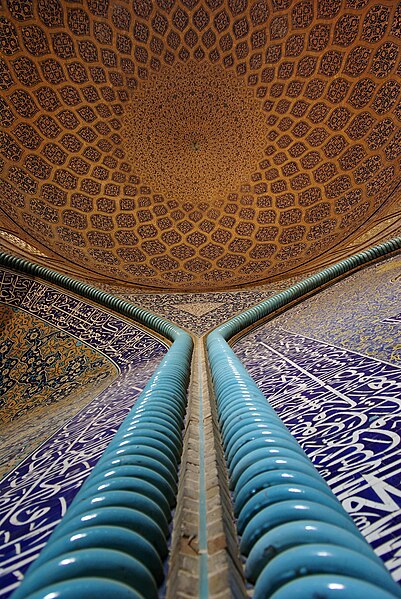.
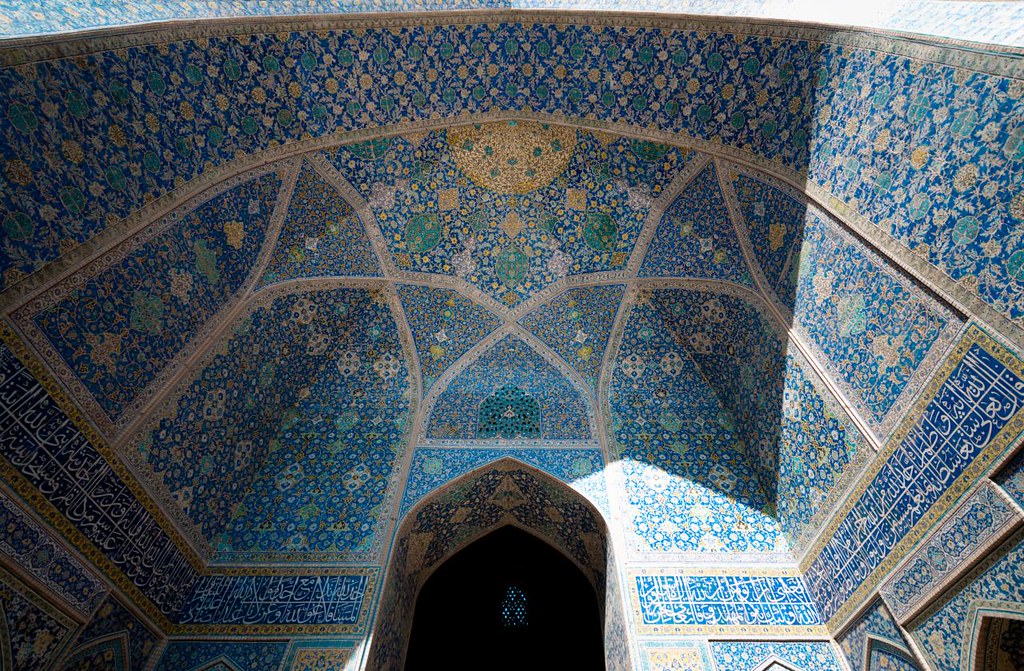
Imam (formerly Shah) Mosque (Masjed-e Imam), Isfahan: photo by Dara Mulhern, 18 October 2010
When I was a child
I thought a handgun in a holster
and the lead colored bullets on the belt
was one of the most beautiful things
made by man.
Of course at that time
I didn't consciously know
of the phallic significance or symbol,
but it doesn't really matter.
It's not the object now
but the feeling that accompanied,
which still remains and comes back,
but not for guns and bullets
but for eternity.
It must be the way Sumerians
felt for their Gilgamesh
and Jews for David
and Egyptians for Pharaoh
and anyone for heroes,
a hope of eternity
for ever and ever new.
A chance not for the object
but for the soul alone,
if that be possible.
But it's too easy
to love life too much
and all is gone away, alas,
like a shot from
the gun of childhood.
When I was a child
I thought of eternity.
Joseph Ceravolo (1934-1988): Hand Gun, 24 October 1986, from Collected Poems, 2012
Against the lucidity of instinct he opposed the instinct for lucidity: the invisible is not obscure or mysterious, it is transparent...
Octavio Paz on Marcel Duchamp, in Paz: Marcel Duchamp: Appearance Stripped Bare, translated by Rachel Phillips and Donald Gardner, 1978
The conventional view holds that girih (geometric star-and-polygon, or strapwork) patterns in medieval Islamic architecture were conceived by their designers as a network of zigzagging lines, where the lines were drafted directly with a straightedge and a compass. We show that by 1200 C.E. a conceptual breakthrough occurred in which girih patterns were reconceived as tessellations of a special set of equilateral polygons ("girih tiles") decorated with lines. These tiles enabled the creation of increasingly complex periodic girih patterns, and by the 15th century, the tessellation approach was combined with self-similar transformations to construct nearly perfect quasi-crystalline Penrose patterns, five centuries before their discovery in the West.
Decagonal and Quasi-Crystalline Tilings in Medieval Islamic Architecture, by Peter J. Lu and Paul J. Steinhardt: abstract of a paper in Science 23, February 2007, Vol. 315. no. 5815
For all their tantalizing glimpses into medieval scientific knowledge, the designs of the Darb-i Imam [in Isfahan, taken by Peter Lu as a template for his thesis] and other Islamic buildings must also be understood in their religious context. Geometric patterns in Islamic architecture and ornamentation were used as much for spiritual as for artistic reasons. As Robert Irwin writes in his study of Islamic art, such patterns may have been viewed 'as exteriorized representations of abstract, even mystical, thought' -- aiming to inspire contemplation or to make a statement about the imponderable harmonies of a divinely ordered universe. Sufism in particular is closely linked to the practice of geometry, above all in the form of symmetries, as a way of giving physical expression to mystical thought.
The girih designs are thus comparable to Gothic art and architecture in another sense, namely in their shared ambition to embody spiritual cogitation and emotion through geometry. The real significance of the magnificent tiling of the Darb-i Imam lies not in any kind of cultural one-upmanship about who first conceived a certain idea or technique, but rather in the remarkable trajectories of ideas and scientific endeavors through time.
Sebastian R. Prange, on the Lu thesis, in Islamic Arts and Architecture, 20 May 2012
I thought a handgun in a holster
and the lead colored bullets on the belt
was one of the most beautiful things
made by man.
Of course at that time
I didn't consciously know
of the phallic significance or symbol,
but it doesn't really matter.
It's not the object now
but the feeling that accompanied,
which still remains and comes back,
but not for guns and bullets
but for eternity.
It must be the way Sumerians
felt for their Gilgamesh
and Jews for David
and Egyptians for Pharaoh
and anyone for heroes,
a hope of eternity
for ever and ever new.
A chance not for the object
but for the soul alone,
if that be possible.
But it's too easy
to love life too much
and all is gone away, alas,
like a shot from
the gun of childhood.
When I was a child
I thought of eternity.
Joseph Ceravolo (1934-1988): Hand Gun, 24 October 1986, from Collected Poems, 2012
Against the lucidity of instinct he opposed the instinct for lucidity: the invisible is not obscure or mysterious, it is transparent...
Octavio Paz on Marcel Duchamp, in Paz: Marcel Duchamp: Appearance Stripped Bare, translated by Rachel Phillips and Donald Gardner, 1978
The conventional view holds that girih (geometric star-and-polygon, or strapwork) patterns in medieval Islamic architecture were conceived by their designers as a network of zigzagging lines, where the lines were drafted directly with a straightedge and a compass. We show that by 1200 C.E. a conceptual breakthrough occurred in which girih patterns were reconceived as tessellations of a special set of equilateral polygons ("girih tiles") decorated with lines. These tiles enabled the creation of increasingly complex periodic girih patterns, and by the 15th century, the tessellation approach was combined with self-similar transformations to construct nearly perfect quasi-crystalline Penrose patterns, five centuries before their discovery in the West.
Decagonal and Quasi-Crystalline Tilings in Medieval Islamic Architecture, by Peter J. Lu and Paul J. Steinhardt: abstract of a paper in Science 23, February 2007, Vol. 315. no. 5815
For all their tantalizing glimpses into medieval scientific knowledge, the designs of the Darb-i Imam [in Isfahan, taken by Peter Lu as a template for his thesis] and other Islamic buildings must also be understood in their religious context. Geometric patterns in Islamic architecture and ornamentation were used as much for spiritual as for artistic reasons. As Robert Irwin writes in his study of Islamic art, such patterns may have been viewed 'as exteriorized representations of abstract, even mystical, thought' -- aiming to inspire contemplation or to make a statement about the imponderable harmonies of a divinely ordered universe. Sufism in particular is closely linked to the practice of geometry, above all in the form of symmetries, as a way of giving physical expression to mystical thought.
The girih designs are thus comparable to Gothic art and architecture in another sense, namely in their shared ambition to embody spiritual cogitation and emotion through geometry. The real significance of the magnificent tiling of the Darb-i Imam lies not in any kind of cultural one-upmanship about who first conceived a certain idea or technique, but rather in the remarkable trajectories of ideas and scientific endeavors through time.
Sebastian R. Prange, on the Lu thesis, in Islamic Arts and Architecture, 20 May 2012
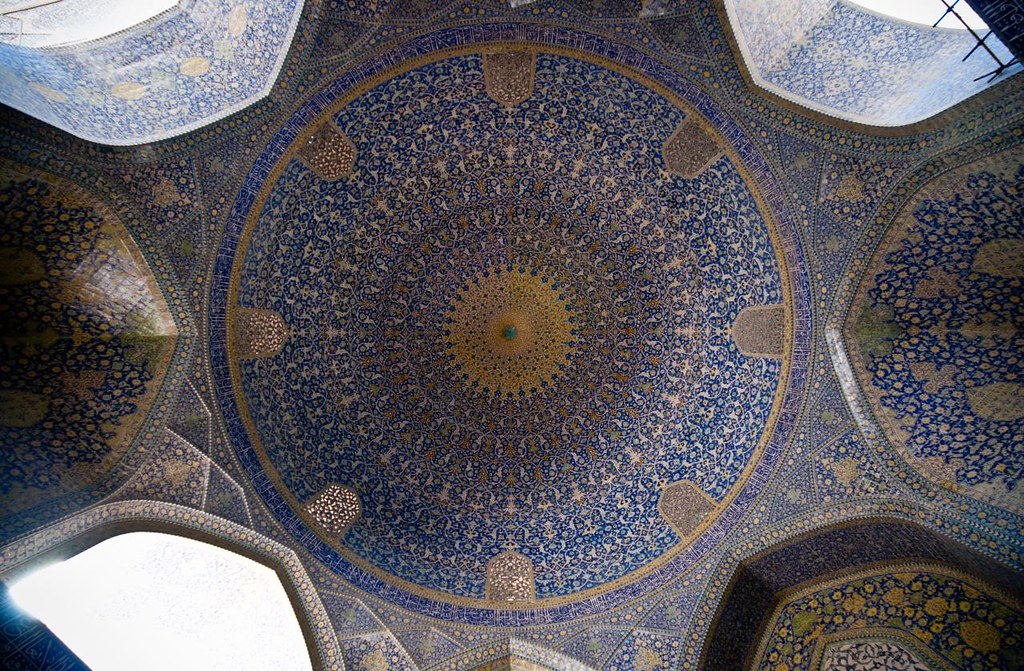
Main Dome, Imam (formerly Shah) Mosque (Masjed-e Imam), Isfahan (1611-1629}: photo by Dara Mulhern, 18 October 2010

Side Dome, Imam (formerly Shah) Mosque (Masjed-e Imam), Isfahan: photo by Dara Mulhern, 18 October 2010
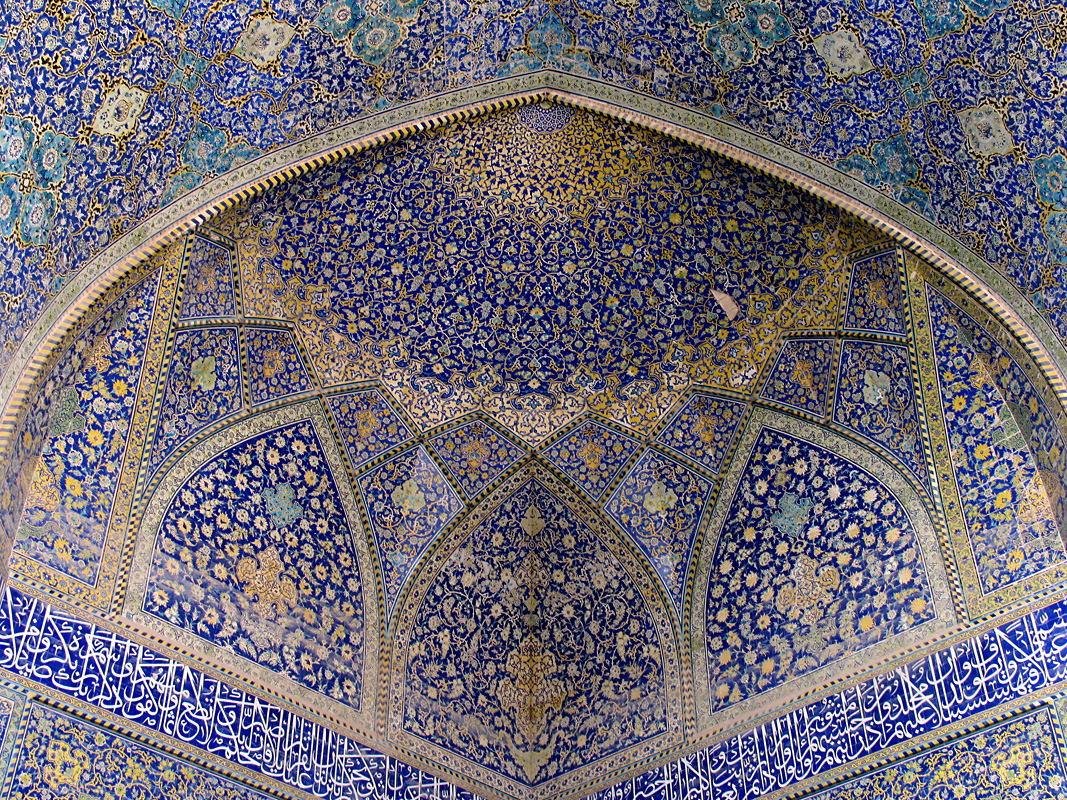
Imam (formerly Shah) Mosque, Isfahan: photo by HORIZON, 18 May 2006
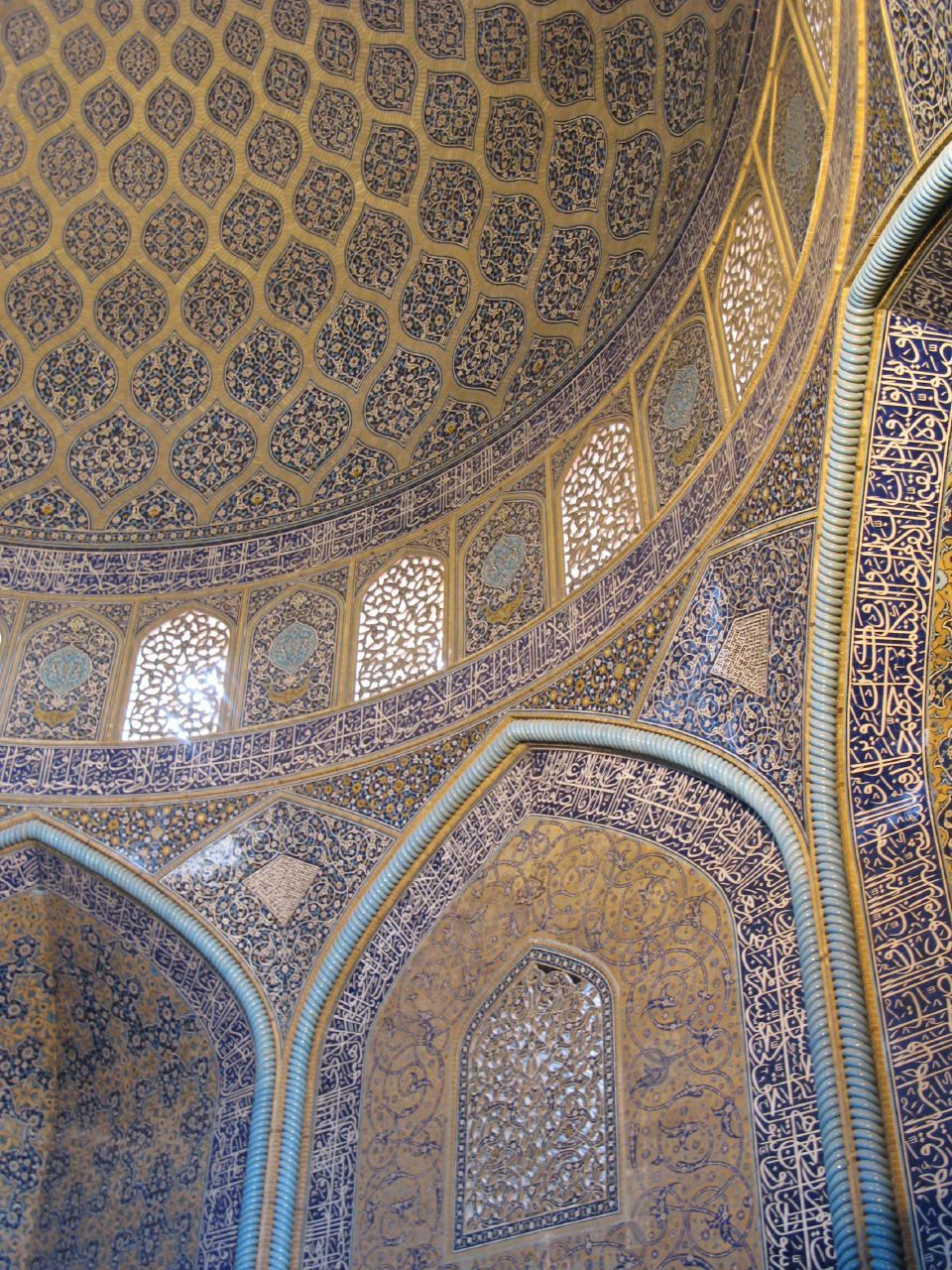
Sheikh Lotf Allah Mosque, Isfahan: photo by oceanbaby, 4 May 2007
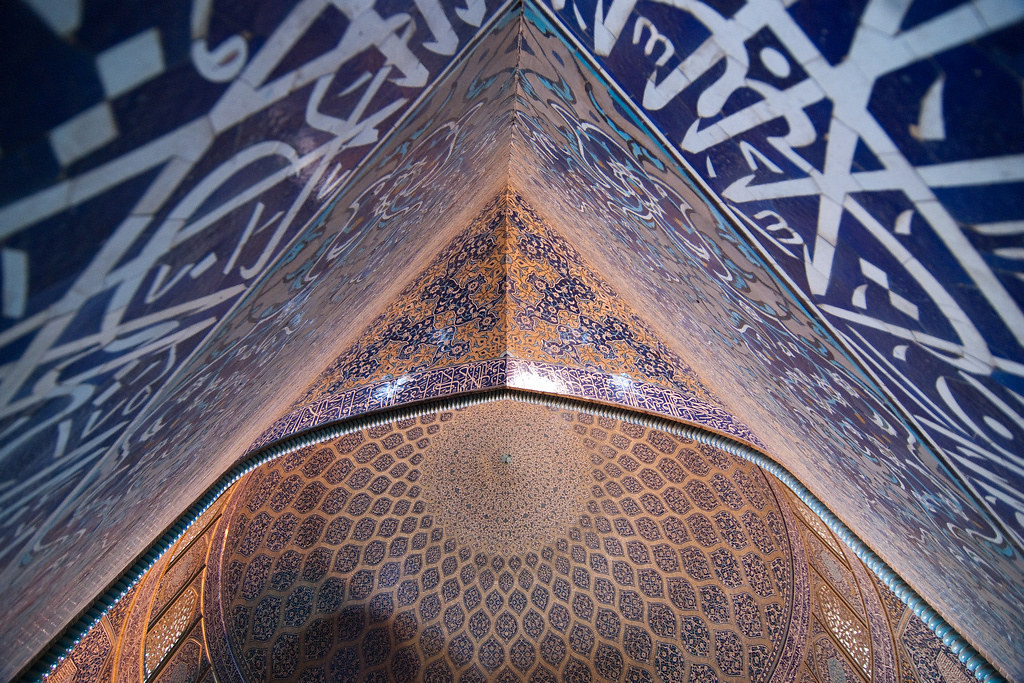
Sheikh Lotf Allah Mosque, Isfahan: photo by Behrooz Bashokooh, 15 March 2011
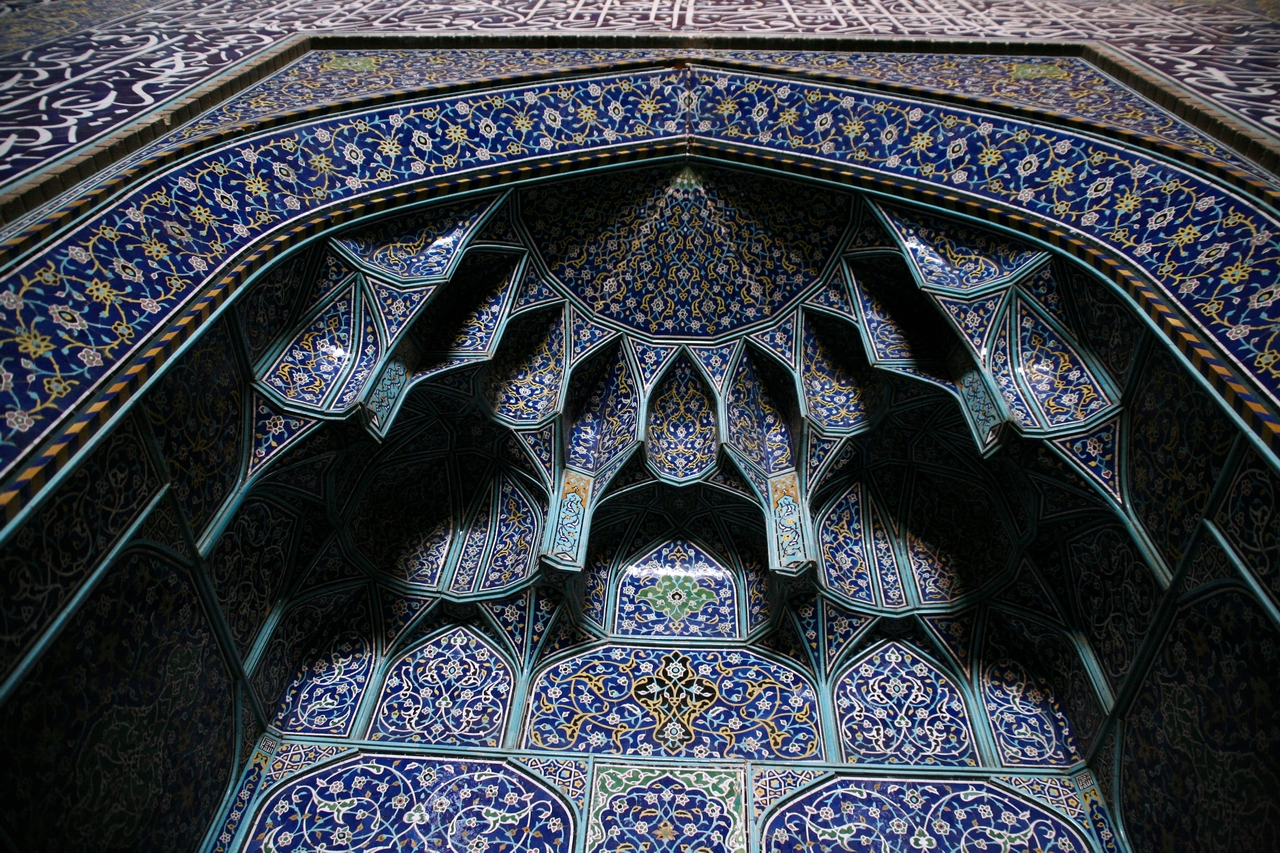
Muqarnas, Sheikh Lotf Allah Mosque, Isfahan: photo by Mandana Fard (baraneh), 8 January 2008

